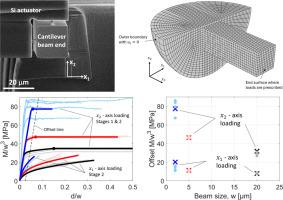Non-proportional plastic deformation at the micron scale: Single crystal Cu cantilever beams subjected to orthogonal bending
IF 6
2区 工程技术
Q2 MATERIALS SCIENCE, MULTIDISCIPLINARY
引用次数: 0
Abstract
Experiments involving abrupt non-collinear changes in the direction of loading in the plastic range have been performed on micron-scale, single crystal Cu cantilever beams to provide the first data of its kind on non-proportional loading. The data is used to assess whether existing strain gradient plasticity (SGP) theories are capable of reproducing complex deformation histories representative of micron-scale metal forming processes, for which non-proportional loading is common. The data is also used to explore an issue that has arisen in efforts to develop SGP that is sufficiently accurate for engineering applications and yet not overly complex. Specifically, using a combination of experimentation and computation, the paper examines the differences in predictions made by two classes of theories presently in the mainstream, termed “incremental” and “non-incremental”, when non-proportional plastic loading occurs at the micron scale. Orthogonal bend experiments are performed on Cu single crystal cantilever beams with square cross-sections that are symmetrically oriented with respect to the vertical and horizonal bending axes. In Stage 1, the force applied to the end of the cantilever is vertical, producing bending in the vertical plane. Abruptly, in Stage 2, a horizontal force is applied with either the vertical force held constant (force control) or the vertical end-displacement of the beam held constant (displacement control). Three cantilever sizes, with widths of the square cross-section of 2, 5 and 20 microns, have been tested. The strength elevation for cantilever widths decreasing from 20 to 2 microns is about a factor of three as compared to what would be expected based on conventional plasticity theory. The incremental and non-incremental SGP theories both capture the full non-proportional loading history, including the size effect. However, they differ in their predictions of behavior in the early portion of Stage 2, due to the abrupt change in the loading path. This difference will be assessed with the aid of experimental test data.

微米尺度下的非比例塑性变形:单晶铜悬臂梁受正交弯曲
在微米尺度的单晶铜悬臂梁上进行了塑性范围内加载方向突然非共线变化的实验,提供了此类非比例加载的第一个数据。这些数据用于评估现有的应变梯度塑性(SGP)理论是否能够再现具有代表性的微米尺度金属成形过程的复杂变形历史,其中非比例加载是常见的。这些数据还用于探索在开发SGP的努力中出现的一个问题,该问题对于工程应用来说足够精确,但又不过于复杂。具体地说,使用实验和计算相结合的方法,本文检验了目前主流的两类理论(称为“增量”和“非增量”)在非比例塑性加载发生在微米尺度时的预测差异。对铜单晶悬臂梁进行了正交弯曲实验,该梁具有相对于垂直和水平弯曲轴对称取向的方形截面。在阶段1中,施加在悬臂末端的力是垂直的,在垂直平面上产生弯曲。突然,在第二阶段,施加水平力时,要么垂直力保持不变(力控制),要么梁的垂直端位移保持不变(位移控制)。已经测试了三种尺寸的悬臂,其宽度为2微米,5微米和20微米的方形横截面。与传统塑性理论相比,悬臂宽度从20微米降低到2微米的强度提升约为三倍。增量和非增量SGP理论都捕获了完整的非比例加载历史,包括尺寸效应。然而,由于加载路径的突变,他们在第二阶段早期的行为预测上存在差异。这种差异将借助实验测试数据进行评估。
本文章由计算机程序翻译,如有差异,请以英文原文为准。
求助全文
约1分钟内获得全文
求助全文
来源期刊
CiteScore
9.80
自引率
9.40%
发文量
276
审稿时长
52 days
期刊介绍:
The aim of Journal of The Mechanics and Physics of Solids is to publish research of the highest quality and of lasting significance on the mechanics of solids. The scope is broad, from fundamental concepts in mechanics to the analysis of novel phenomena and applications. Solids are interpreted broadly to include both hard and soft materials as well as natural and synthetic structures. The approach can be theoretical, experimental or computational.This research activity sits within engineering science and the allied areas of applied mathematics, materials science, bio-mechanics, applied physics, and geophysics.
The Journal was founded in 1952 by Rodney Hill, who was its Editor-in-Chief until 1968. The topics of interest to the Journal evolve with developments in the subject but its basic ethos remains the same: to publish research of the highest quality relating to the mechanics of solids. Thus, emphasis is placed on the development of fundamental concepts of mechanics and novel applications of these concepts based on theoretical, experimental or computational approaches, drawing upon the various branches of engineering science and the allied areas within applied mathematics, materials science, structural engineering, applied physics, and geophysics.
The main purpose of the Journal is to foster scientific understanding of the processes of deformation and mechanical failure of all solid materials, both technological and natural, and the connections between these processes and their underlying physical mechanisms. In this sense, the content of the Journal should reflect the current state of the discipline in analysis, experimental observation, and numerical simulation. In the interest of achieving this goal, authors are encouraged to consider the significance of their contributions for the field of mechanics and the implications of their results, in addition to describing the details of their work.

 求助内容:
求助内容: 应助结果提醒方式:
应助结果提醒方式:


